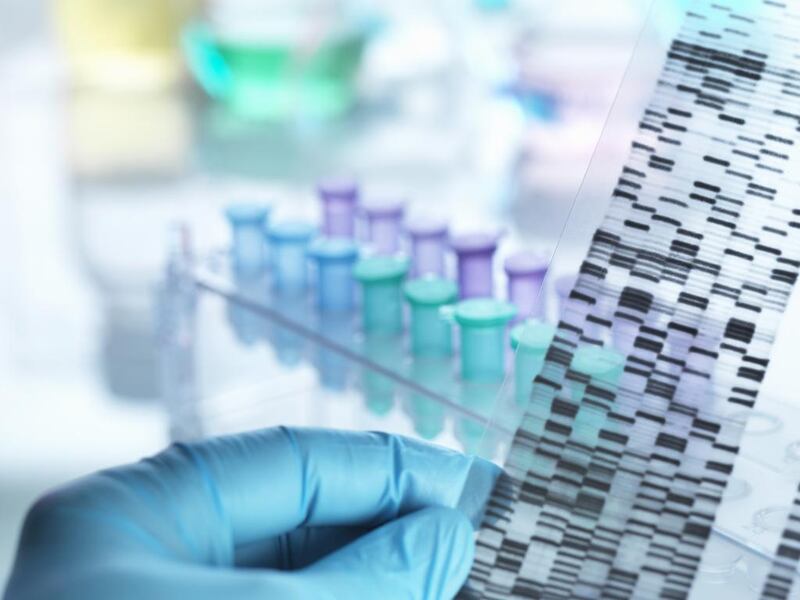There are few things more difficult for parents than finding out that their child has a serious illness or disability with a genetic cause.
Sadly, it is a scenario that Arab parents have often faced because many congenital conditions are more common in the Middle East than in other parts of the world.
Recent work by the Centre for Arab Genomic Studies in Dubai, a division of the Sheikh Hamdan bin Rashid Al Maktoum Award for Medical Sciences, has focused on these disorders.
The centre announced that its research with Latifa Hospital in Dubai had helped to identify 16 mutations on 14 genes linked to a dozen hereditary diseases found in Arab children.
The work – involving 20 people from the UAE, Jordan, Sudan and Yemen – could contribute to early detection and improved treatment.
The high frequency of congenital disorders such as those analysed in the research has often been the result of traditional marriage practices.
“We see them more in our part of the world because of consanguineous marriages,” said Dr Laila Zahed, a geneticist at the University of Balamand in Lebanon and a former council member of the centre.
Consanguineous marriages pertain to the union of couples who are blood relations. As many as 30 per cent of marriages within some Middle East communities are between first cousins, according to estimates.
These unions increase the chance of children being born with genetic abnormalities by allowing harmful, recessive forms of genes to exert their effects.
The UAE researchers found a mutation that can cause Rabson-Mendenhall syndrome, in which tissues and organs fail to respond to insulin. That causes muscle weakness, short stature and skin problems, which arise from mutations in the insulin-receptor gene.
The syndrome, which can result in a life expectancy of one to two years, is also found in other parts of the world. In a study by other researchers published last year, another mutation of the gene was identified from a genetic analysis of an 11-year-old Sri Lankan boy who displayed abnormalities including skin problems and stunted growth. Like many children with this condition, his parents were related.
Like congenital disorders in the Arab world and elsewhere, Rabson-Mendenhall syndrome is an “autosomal recessive” disorder.
Autosomal means the relevant gene is found on one of the autosomes, the non-sex chromosomes, of which humans have 22 pairs, one from each parent.
Recessive refers to the fact that if a person inherits the normal form of the gene from one parent, they will not have the disorder even if they inherit the defective form from the other parent. Instead, they must inherit the defective form from both parents – a more likely outcome from the union of genetically similar blood relations.
Another factor that makes certain disorders common in the region is that when defective genes are inherited from just one parent instead of both, they confer resistance to diseases that have been prevalent in the region.
This partly explains the high frequency of thalassaemia, a group of genetic blood disorders that are associated with resistance to malaria.
There are other disorders that are so rare that they have never been properly identified and are associated with very small numbers of families.
“You cannot categorise or elucidate the disorder. The kids didn’t live long enough for a diagnosis or the disorder is so rare. When you have only one or two families, it’s much more difficult to understand what the gene is behind it,” said Dr Zahed.
Nevertheless, the understanding of many other more common disorders is improving.
For example, the UAE researchers also identified mutations in two genes, ECEL1 and CHRNG, that are associated with arthrogryposis, a condition that causes joint problems and weakness, especially in the hands and feet.
They also found a new mutation in a gene called SOX18. This mutation causes hypotrichosis-lymphedema-telangiectasia syndrome, which is linked to edema (swelling from fluid retention) in the lower limbs, and hair loss.
There are several reasons behind scientists’ rapid progress in understanding the genetic basis of disease.
One of the reasons was that sample sizes were much larger because the cost of genetic analysis had fallen considerably, said Dr Garrett Hellenthal, a research fellow at University College London, who has a doctorate in genetics from the University of Washington, Seattle.
While the total investment in the first sequencing of a human genome was US$2.7 billion (Dh9.9bn), today the cost is likely to be about $1,500.
“Genetic data, you can capture it in lots and lots of individuals. It increases your power to find genetic variants in specific locations of DNA,” said Dr Hellenthal.
“The second reason is the development of statistical methods that can analyse that data. Some of these have got a bit more sophisticated, in particular about dealing with large quantities of data.”
This was particularly important for identifying rare diseases or for carrying out analysis of a genome, the complete set of an individual’s genetic material, said Dr Hellenthal.
“One of the common things is a simple mutation at a single position. That’s relatively straightforward to analyse. There’s other things where you have got segments of DNA that are missing or you have extra copies. The methods to find these features and which are associated with raised risk of diseases have improved considerably,” he said.
“That’s contributed to finding new genetic issues or genetic markers. With the old studies, you wouldn’t get all the genetic variation, but a subset.
“Now, with technology, you’re able to get all the mutations relatively cheaply. That allows you to get the rare mutations.”
A third factor Dr Hellenthal cited was better diagnosis, which made it easier to identify the genetic basis for particular conditions.
So as the tools developed by scientists improve, and couples are educated about the risks of consanguinity, the hope is that harmful congenital disorders will become less common in the region and globally.
newsdesk@thenational.ae







